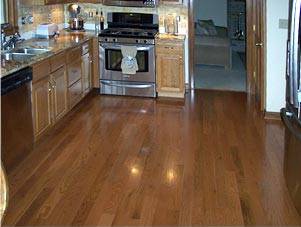Yes, hardwood flooring can be installed in a kitchen, as shown in Figure 1. In fact hardwood flooring is an excellent choice for almost any room in your home with the exception, due to high quantities of humidity, of full bathrooms (those with showers) and laundry rooms.

Figure 1 - Hardwood Flooring Installed In A Kitchen
However, there are some additional considerations when installing hardwood flooring in a kitchen:
- Appliances:
- Cabinets:
The hardwood flooring should definitely be installed under refrigerators and any other moveable appliance such as a range. But what should one do with appliances such as dishwashers or built in ranges?
If a hardwood floor is laid up to a dishwasher rather than laid underneath the dishwasher, you may save some money on material and labor but could block the dishwasher into position so that it cannot be easily removed for repair or replaced. Your hardwood floor will have a much longer life than any appliance including any currently installed dishwasher.
Kitchen cabinets have always been a dilemma for hardwood flooring installations. There are advantages and disadvantages no matter whether you install the hardwood under the base cabinets or butt the hardwood up against the base cabinets.
- Advantages of having hardwood flooring under the base kitchen cabinets:
- Installation is easier as you will not have to cut and trim boards to fit up against the toe kick of the cabinets.
- It may eliminate the need for a molding along the base cabinet toe kick. It should be noted that if your floors are not flat and true, that the cabinet installers (or if this is a diy project - you) will generally shim the bottoms (under the toe kick) of the base cabinets to ensure that the countertop is level. In this case a molding along the toe kick to hide the shims may be necessary.
- Cabinets can be replaced or changed without concern for the flooring.
- Dishwashers and other under cabinet appliances can be easily removed for repair or replacement.
- Disadvantages of having hardwood flooring under the base kitchen cabinets.
- Added expense for hardwood flooring material and installation for areas that will never be seen.
- Possible damage to floors during cabinet installation. Kitchen cabinets are heavy and have sharp edges along the base. The possibility that the cabinet installers or you, may create dents and scratches inadvertently when installing cabinets is high.
- Repairs to boards or slats, if they run length wise under base kitchen cabinets can be difficult without removing the cabinets, a time consuming project at the very least.
Kitchen Hardwood Flooring Installation Suggestions:
- Install the hardwood flooring before installation of the base cabinets.
- After the hardwood flooring is installed, cover the floor with Masonite or old pieces of wall to wall carpeting, to protect the flooring during the cabinet installation. Cardboard or paper will not provide enough protection.
- If you are hiring a contractor, to install the kitchen cabinets, make sure they are competent and understand the value and cost of a hardwood floor!
Mark the cabinet locations and install the flooring in the same direction as the majority of the base cabinets (making it easier for repairing the flooring at a later date if necessary).
Install the hardwood flooring so that it is just under the edge of the cabinet positions. Use plywood, the same thickness of the flooring to finish the area under the cabinets.
This will ensure that under counter appliances are at the correct height, save money on hardwood flooring material and labor in areas where it will not be seen.
Following these suggestions will provide you with all of the advantages and none of the disadvantages
